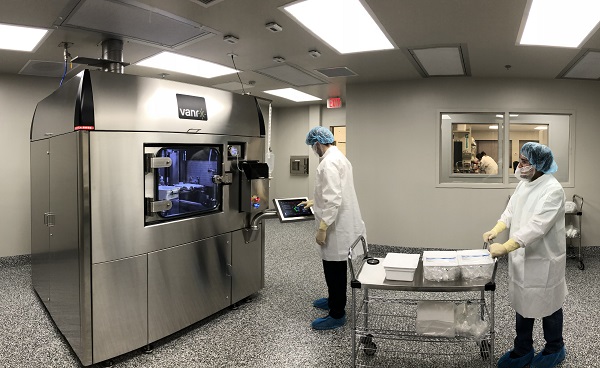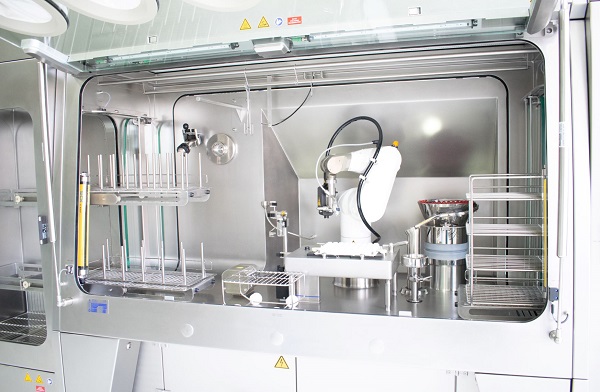Selecting The Right Isolator For Cell Therapy Manufacturing: Considerations & Challenges
By Herman F. Bozenhardt and Erich H. Bozenhardt
As cell therapies move toward commercial production through scale up and multiple capacity increases, we as an industry have not come to grips with how to reliably and economically provide the needed capacity within the open manual processes that we have been working with for many years. Automated systems are on the market for some cell manipulations, but there are still operations that doggedly hold out, as some processes don’t have a closed automated solution and those that do may require additional flexibility to adapt to process variability.
industry have not come to grips with how to reliably and economically provide the needed capacity within the open manual processes that we have been working with for many years. Automated systems are on the market for some cell manipulations, but there are still operations that doggedly hold out, as some processes don’t have a closed automated solution and those that do may require additional flexibility to adapt to process variability.
Biological safety cabinets (BSCs), the traditional means to provide product/patient protection in these therapies, have suited their initial research and development. The scale up and out of this method, however, perplexes companies, either with the risks of rooms filled with BSCs or the cost of many rooms with a small number of BSCs to provide segregation. An isolator, possibly with a robotic/mechanical assist, can provide the advantages of a closed system but still allow the necessary flexibility. There are many choices that can be made in picking the right isolator for cell therapy applications.
This article will focus on what questions a company needs to ask when considering alternatives to manual processes. We will also provide a list of requirements and attributes you need to consider before buying your isolator solution.
History Of Isolator Offerings
The first generation of isolator offerings grew out the adaptation of nuclear gloveboxes for aseptic and containment systems in the 1980s. The original isolators in the pharmaceutical business were used to protect operators during weighing and dispensing of highly potent compounds and radiological materials. These isolators focused on water or chemical washing of the interior to flush, capture, and contain any residual materials. Sterilization came later, with the use of harsher cleaning chemicals.
By the late 1990s, containment isolators were being designed to deal with more dimensionally complex equipment, but they typically were customized for the equipment. This meant the template specification for a pharmaceutical industry isolator was specific to a particular vendor’s equipment (e.g., an XYZ filling machine), and any deviation from the equipment required major customization.
The next and most modern generation of isolators focused on providing a barrier between the operators and the vials on an aseptic filling system in order to eliminate particle and microbial contamination. The result was vaporized hydrogen peroxide (VHP) gassing of the entire interior and HEPA filtered air at a laminar downward flow. The resulting evolution has purposely been to maintain an environment that is not supportive of cellular growth. For aseptic isolators, the dimensions and ergonomics of the systems have been optimized for the linear layout of filling systems and maximum kill cycle between batches (often with residuals).
As the immediate need for environments for small-scale cell manipulation increased, the industry turned to greater use of BSCs. Although most of them provide ISO 5 air in the cabinet, the air curtain did not provide good microbial practices, led to contamination, was an insufficient barrier to protect technicians using them, and often created unacceptable airflow patterns in the cleanroom.
One of the other aspects of the isolator is providing a “closed process” environment. That is only realistic if the closed environment supports the cell line with the temperature, humidity, nutrient gas concentration, and absence of oxidizing chemicals in the vapor state.
What Is Needed?
The following is a list of items for a user requirements specification (URS) that one needs to consider in addition to the standard isolator electrical and mechanical requirements:
- Does the isolator encapsulate: 1) a biological process, 2) a mechanical operation, or 3) an aseptic filling? Are we protecting a cell line, an operator, or a material from microbial or particulate contamination?
- What is the throughput of the operation?
- How does the throughput impact the size?
- What does the machine operation require?
- Is the robot a stand-alone machine?
- Does the robot need to be served by another machine or human?
- Are there physical constraints, including the need to integrate certain types of equipment through the isolator?
- What does the human intervention require?
- Dexterity, reach, and lifting requirements
- Staging/placement of materials
- Should there be any human intervention ever?
- Biosafety level: BSL1 or BSL 2, and how are materials decontaminated?
- How can materials enter/exit and what is their sensitivity?
- Are physiological support conditions needed, such as the gas environment?
- How repetitive is any task and, if so, should a robot be employed?
- Is it for clinical or commercial scale?
- Is sterilizing the interior with VHP or chemicals or other methods allowable and is there an impact of residual gas?
- Is there an opportunity to sterile filter? Or otherwise sterilize?
- Is there a need for product/batch segregation?
Considerations For Selecting An Isolator
1. Method/Process
Cell therapy processes vary widely among products. Even the common operation of cell expansion utilizes many different technologies. Fully closed single-use disposable systems have the ability to allow segregation, control contamination risk, and automate the processes, but they are not available for every variant of cell therapy processing. There are several processes that are major obstacles to utilizing a closed system:
- Initial donation processing/vial break
- Cell passage in some 2D cell culture technologies
- Media supplementation from vials or bottles
- Aseptic filling into a vial or device
- Manipulations/additions at the µL scale
The flow of the process may require sequential operations to be performed with minimal time between steps, for efficiency/capacity or product quality reasons. For example, after thawing a vial, how is the cryo-preservative quenched/removed and how much time can be allowed before completion of that step?
2. Machines, Robotics, and Mechanical Systems
Isolator requirements for physiological conditions could be taken different ways depending on the process. In some cases, we are focused on including or having the ability to dock to an incubator. Sometimes we are concerned about particular aspects of the environment of the operation (e.g., VHP residual, humidity, temperature). Still other processes have seen advantages in operating an isolator as if it were a bioreactor during the open operations, with temperature, humidity, and gas control.
The environment is relatively straightforward to control, but the manipulation within may or may not be. As we adapt and evolve molecular biology methods for commercial therapies, the starting point is usually fully manual. Simple mechanical jigs can improve the repeatability within the operation with minimal cost but typically lack flexibility to perform different operations. Robotics are still novel and, while conceptual, a robotic arm could have the same flexibility as a human, but programming the arm limits the flexibility. Mimicking human arms might be a good solution, but it hasn’t been explored in sufficient breadth. Many other industries (e.g., semiconductor) use finely articulating arms, but adaptations applicable to the pharmaceutical industry have been slow. It may be surprisinge’e’90s, the pharmaceutical industry actually led in the use of robotic applications, with its roller bottle handling robots. The key to expanding the usefulness of robotics is to incorporate high-definition cameras with AI to recognize changes in parameters, dimensions, and presentations to trigger different recipes and control actions.
One area of pharmaceuticals that uses robotics is aseptic filling. A couple of different options are available:
- Cartesian robots have three linear axes of movement (up-down, left-right, in-out). These robots are adept at working with nests or trays of items, such as nested syringe filling or automated liquid handlers from high throughput analytic systems. As tempting as it may be to take a liquid handler for analytics and place it in an isolator, be careful to consider what is needed to ensure the robot’s design maintains a Grade A environment and potential decontamination cycles.

Adaptive Phage Therapeutics is using a closed robotic workcell (Vanrx Microcell Vial Filler) for the production of PhageBank, a library of more than 1,000 bacteriophage drug products for personalized treatment of antibiotic-resistant bacterial infections. (Image courtesy of Vanrx Pharmasystems Inc.)
- Spherical robots utilize arms to move in polar/spherical coordinates. These robots have been incorporated in Aseptic Technologies’ L-1 filler, B&S VarioSys’ DDM9105 module, and Sartorius’ CompacTSelecT. This movement is more like the human arm. The ability to rotate supports the manipulations associated with seeding and harvesting 2D cell culture systems.


The photos above show Aseptic Technologies’ Crystal L1 Robot Line in a PSI-L isolator from SKAN, installed at a multi-product gene therapy facility. (Image courtesy of Aseptic Technologies)
Typically, we design isolators to work within 9-foot (3 m) or taller ceilings in manufacturing facilities, but some cell therapies are being manufactured at the point of care. This adds spatial constraints beyond the industry norm and forces us to rethink how we are building the HEPA filtration and air-handling systems on these machines. The alternative is to change the facility ceiling systems and HEPA filter distribution, which needs to be done during the design phase.
3. Operator Actions
The ergonomics of isolators for cell therapy tend to have many manual actions to consider and a long-time duration of work.
- Pipetting (micro pipettes): Will the gloves allow adjustment for different volumes or should multiple preset pipettes be used?
- Pipetting (serological): Will the operator be able to easily see the graduations based on where they stand and where the pipetting needs to happen in the isolator?
- Should the operator be sitting or standing for the operation?
- Does the processing rate require multiple operators to work at once in the isolator?
- What is the environmental monitoring plan? Are there places to accumulate plates? How do plates get in and out?
4. Instrumentation
With respect to the operations that interface with the isolator, key process controls and new instrumentation need to be well thought through:
- Cell passages will need a cell density reading in order to complete the operation.
- What is the best technology for rapidly removing the sample via a rapid transfer port – an airlock or a mouse hole?
The isolator design should also consider the ability to pass samples and data from instruments and equipment within the isolator to an overarching control system or data historian. Depending on the automation architecture, there may be a need to report to multiple systems, such as, for example, equipment operational parameters to a process historian and particle counts to an environmental monitoring system.
5. Environment
Isolators have traditionally focused on keeping out/removing microorganisms. For cell therapy isolators, we need to think more like a Class II biosafety cabinet, where we have to protect both the operator and the process.
For keeping microorganisms out of sterile operations, isolators have traditionally been positive pressure. Regulations start with this as the basis and ask for assessment if alternative schemes are considered. The biological safety risk and cross-contamination risk need to be formally assessed for these processes. This assessment should reference the product/batch segregation philosophy and consider the facility design factors and operator gowning/PPE. The real question is what pressure, if positive, is needed, if any?
Isolators use a sanitization/sterilization step to control contamination when bringing materials in. Typically, this is either a VHP chamber or a laminar flow pass through. Some designs rely on loading the isolator and then sanitizing (manually or otherwise). For segregation philosophies that require sanitization between batches, loading and sanitization might be acceptable, but it would hamper throughput for operations that sanitize on a less frequent schedule. An entrance chamber designed as an improvement step would make sense for those types of operations. The nature of that improvement step would depend on the cleanroom background grade and the sensitivity of the material being transferred in with the sanitization agents. See the article Help! My Isolator is Taking Too Long to Degas — What Should I Do? for more info on VHP degassing and product sensitivity. The nature of the operations and process will drive the need to sanitize versus sterilize incoming material. Typically, cell therapies are conducted aseptically, so sterilization happens before/as material is introduced to the process.
6. Material
The variations among cell therapy process make a uniform material handling approach challenging. One aspect that is common is the increased need to track and trace over that of traditional pharmaceuticals. The interactions with manufacturing execution systems (MES), electronic batch record systems, and bar code readers need to be considered seriously. We are in the year 2020, and we are using the most advanced biotechnology; we cannot be satisfied with manual record keeping. The most likely outcome is a bar code-reading laser outside and inside the isolator to verify what is being moved in (single-use system components) and what is be used in the process (material released by QA), and this is correlated electronically with the recipe production process being executed.
Conclusion
Unfortunately, cost and schedule are always major drivers in equipment selection. This is often the case as we develop and highly customize our equipment and processes. The key in the selection of an isolator is to find a machine, process, and system that best fit your process and product. The ideas discussed above should help you plan for your equipment inquiry and bring the requirements to the forefront. We need to focus on size and application, sanitization/sterilization and its impact on the product, and the available robotic systems and automation.
Cell therapies can give terminal patients an opportunity to survive, while insurance companies are watching for a value-based benefit. Thinking about the appropriate needs for the process and comparing those to standard offerings can help drive quality, cost, and schedule to a mutually beneficial place.
About The Authors:
 Herman Bozenhardt has 44 years of experience in pharmaceutical, biotechnology, and medical device manufacturing, engineering, and compliance. He is a recognized expert in the area of aseptic filling facilities and systems and has extensive experience in the manufacture of therapeutic biologicals and vaccines. His current consulting work focuses on the areas of aseptic systems, biological manufacturing, and automation/computer systems. He has a B.S. in chemical engineering and an M.S. in system engineering, both from the Polytechnic Institute of Brooklyn.
Herman Bozenhardt has 44 years of experience in pharmaceutical, biotechnology, and medical device manufacturing, engineering, and compliance. He is a recognized expert in the area of aseptic filling facilities and systems and has extensive experience in the manufacture of therapeutic biologicals and vaccines. His current consulting work focuses on the areas of aseptic systems, biological manufacturing, and automation/computer systems. He has a B.S. in chemical engineering and an M.S. in system engineering, both from the Polytechnic Institute of Brooklyn.
 Erich Bozenhardt, PE, is the process manager for IPS-Integrated Project Services’ process group in Raleigh, NC. He has 14 years of experience in the biotechnology and aseptic processing business and has led several biological manufacturing projects, including cell therapies, mammalian cell culture, and novel delivery systems. He has a B.S. in chemical engineering and an MBA, both from the University of Delaware.
Erich Bozenhardt, PE, is the process manager for IPS-Integrated Project Services’ process group in Raleigh, NC. He has 14 years of experience in the biotechnology and aseptic processing business and has led several biological manufacturing projects, including cell therapies, mammalian cell culture, and novel delivery systems. He has a B.S. in chemical engineering and an MBA, both from the University of Delaware.
